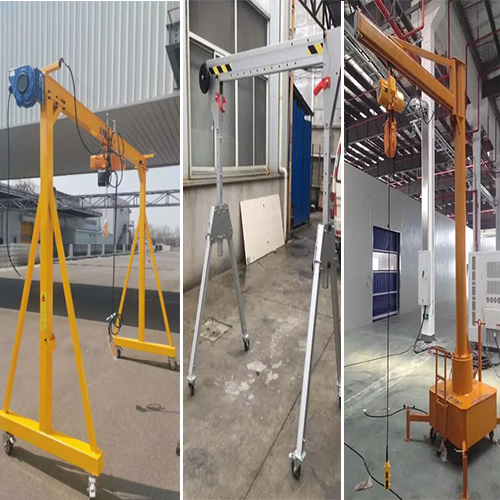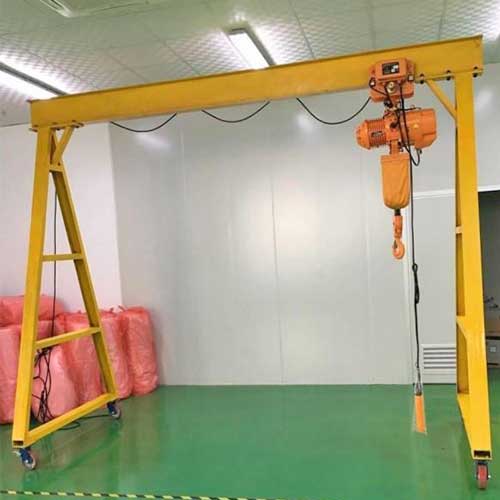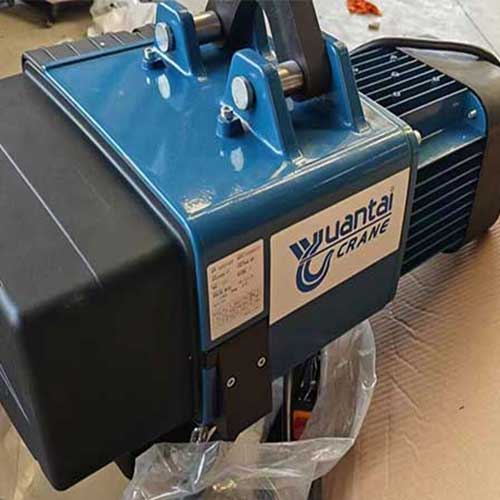Rolling Cranes: Rolling Hoist and Cranes for Efficient Material Handling
Rolling cranes for sale. Custom rolling cranes for efficient material handling in variouse indoor & outdoor use, 1 t, 2 t, 3 t, 5 t, 10t, up to 20 ton.
| Portable Gantry Rolling Crane | 0.5 ton to 10 Ton |
| Aluminum Rolling Crane | 0.25 ton to 5 ton |
| Cantilever Rolling Crane | 0.25 ton to 2 ton |
| Custom Design | Custom rolling cranes are provided. |
Category: Overhead Crane on Wheels
Your Trusted Rolling Crane Manufacturer & Supplier
Rolling Cranes: Rolling Hoists and Cranes for Efficient Material Handling
Rolling cranes for sale. Custom rolling cranes for efficient material handling in variouse indoor & outdoor use, 1 t, 2 t, 3 t, 5 t, 10t, up to 20 ton.
Rolling Cranes: Versatile Solutions for Efficient Material Handling
Rolling cranes stand as essential tools within industrial landscapes, revolutionizing material handling with their adaptability and functionality. These cranes encompass a range of designs and configurations, each tailored to specific tasks and environments, making them pivotal in various industrial operations.
Definition and Overview of Rolling Cranes
Rolling cranes, also known as mobile gantry cranes or rolling jib cranes, represent a class of material handling equipment characterized by their mobility and capacity to lift and transport heavy loads horizontally or vertically. They are structured with a bridge or jib that travels on tracks or wheels, providing flexibility in movement across workspaces.
Importance of Rolling Cranes in Industrial Settings
Within industrial settings, the significance of rolling cranes cannot be overstated. These versatile machines streamline operations by enabling efficient movement, lifting, and precise positioning of heavy loads. Their contribution to increased productivity, reduced labor intensity, and enhanced safety standards makes them indispensable across industries such as manufacturing, construction, warehousing, and more.
Brief Explanation of Keywords
- Rolling Gantry Crane for Sale: Refers to the availability of rolling gantry cranes for purchase, highlighting the market aspect of these versatile machines.
- Rolling Gantry Crane: Denotes the specific type of crane with a gantry structure and movable capabilities, allowing for effective load handling.
- Rolling Gantry: A shorter reference term for rolling gantry cranes, often used informally within industrial circles.
- Rolling Jib Crane: Represents a variation of rolling cranes equipped with a jib for specific material handling tasks, offering adaptability and precision in operation.
- Overhead Rolling Crane: Signifies cranes designed to move along elevated runways, optimizing vertical space utilization within facilities.
- Movable Overhead Crane: Another term denoting the capability of cranes to move across the overhead runways for efficient material handling.
- Rolling Shop Crane: Used in workshops or smaller work environments, these cranes are versatile and mobile, aiding in various maintenance and lifting tasks.
- Rolling Crane, Rolling Bridge Crane, Portable Bridge Crane: General references encompassing different types of cranes with mobility and load-handling capabilities, tailored for specific industrial requirements.
- Rolling Crane Hoist: A focused term highlighting the lifting mechanism aspect within the rolling crane system.
Portable Gantry Rolling Cranes:
Rolling gantry cranes, characterized by their gantry structure and movable nature, boast a horizontal beam (gantry) supported by legs that travel on wheels or tracks. They come in various configurations, such as single or double girder, with hoisting mechanisms adaptable to specific load capacities.
These cranes often incorporate user-friendly controls, facilitating precise load positioning and movement within a workspace. Their design emphasizes maneuverability and versatility, making them suitable for a wide array of material handling tasks.
Types of Portable Rolling Gantry Cranes

Portable Rolling Gantry Cranes 1 ton to 10 ton
Portable design: Easily movable for flexible use.
Versatile for various lifting tasks: Offers stability and support for moderate loads.
Utilized across industries: Commonly found in workshops, construction sites, and maintenance facilities for on-the-go lifting needs.
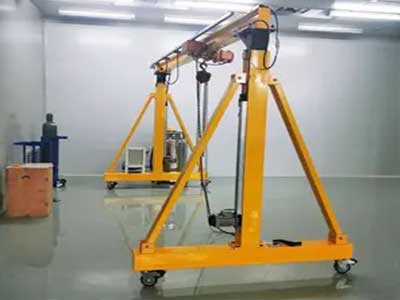
Adjustable Height Rolling Gantry Cranes 1 Ton, 3 Ton, 5 Ton, 10 Tons
Features Overview: Equipped with mechanisms allowing height adjustment, often using hydraulic or manual systems.
Benefits in Versatility and Mobility: Offers adaptability in lifting heights, making it versatile for different load sizes and working environments.
Typical Applications and Industries: Ideal for manufacturing facilities, maintenance operations, and limited clearance environments.
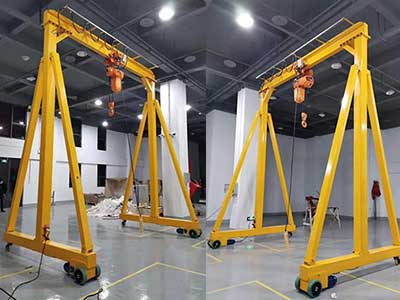
Fixed Height Rolling Gantry Cranes up to 10 Ton
Features Overview: Designed with a fixed beam height, offering stability during lifting operations.
Advantages in Stability and Load Capacity: Suitable for consistent lifting tasks and providing reliable support for moderate to heavy loads.
Common Utilization in Various Industries: Found in manufacturing facilities, warehouses, and assembly lines for routine lifting operations.
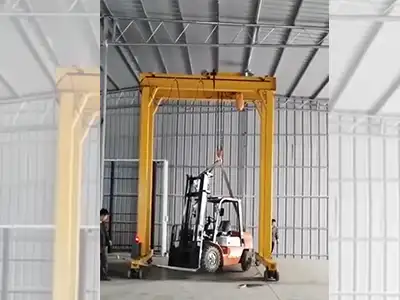
Roller Travelling Double Beam Rolling Gantry Crane 5 Ton, 10 Ton
Overview:
Fixed beam height design: Ensures stability during lifts.
Ideal for consistent lifting tasks: Reliable support for moderate to heavy loads.
Widely used in manufacturing, warehouses, and assembly lines: Facilitates routine lifting operations.
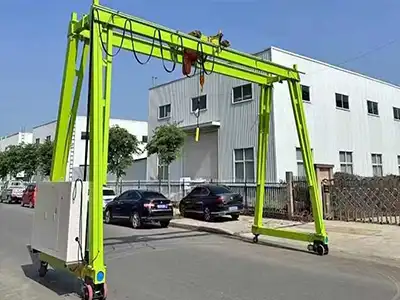
Electric Battery Rolling Gantry Cranes
Powered by electric batteries: Enables efficient and eco-friendly operation.
Enhanced mobility and versatility: Suitable for indoor and outdoor applications.
Ideal for diverse lifting tasks: Provides stable support for moderate loads in various industrial settings.
Customizable Rolling Gantry Cranes with Double Girder Deam (10 Ton for sale Chile project for your reference )
Tailored Solutions: Manufacturers offer customization options tailored to specific industrial needs.
Modular Configurations: Allows for customization of features such as control systems, lifting capacities, or specialized adaptations.
Adaptability: Custom designs cater to unique environments or specialized lifting requirements within industrial settings.
Each type of portable rolling crane caters to distinct operational needs, offering various benefits and functionalities suited for different industries and specific lifting applications.
Advantages of Portable Rolling Cranes
Rolling gantry cranes find applications across diverse industries due to their adaptability and efficiency. They are employed in settings where lifting and moving heavy loads are integral to operations. Some key advantages include:
Flexibility in Load Handling: These cranes offer adaptability in lifting various load sizes and shapes.
Enhanced Mobility: With their movable design, they cover expansive work areas efficiently.
Space Optimization: Rolling gantry cranes make optimal use of floor space while facilitating seamless load movement.
Versatility: They can be customized to suit specific load capacities and operational requirements.
Industrial Applications of Portable Rolling Cranes
Rolling gantry cranes have widespread applications in various industries:
Manufacturing: Used for assembly line processes, transporting heavy components, and aiding in production tasks.
Warehousing: Facilitates efficient storage and retrieval operations within warehouses, optimizing space utilization.
Construction: Assists in lifting and positioning construction materials at job sites, enhancing productivity and safety.
Automotive and Aerospace: Plays a crucial role in handling components during manufacturing in these industries.
Maintenance Workshops: Ideal for lifting and maintaining heavy equipment and machinery.
The adaptability and efficiency of rolling gantry cranes make them indispensable across diverse industries, contributing significantly to streamlined material handling processes and operational efficiency.
Aluminum Rolling Cranes
Aluminum gantry rolling cranes are versatile lifting solutions designed for portability, flexibility, and durability. These rolling cranes are constructed primarily from lightweight aluminum, making them easy to transport and maneuver while still providing robust lifting capabilities. They typically feature a rolling gantry design, allowing them to be moved effortlessly along a track or floor surface to various locations within a workspace. Aluminum rolling cranes come in various configurations, including fixed span and height models, as well as those with adjustable span and height capabilities. Some models may also offer foldable designs for convenient storage and transportation when not in use. These cranes find applications across a wide range of industries, including manufacturing, construction, warehouses, maintenance facilities, and more. They are commonly used for lifting and moving materials, equipment, and products in both indoor and outdoor settings. With their lightweight yet sturdy construction and adaptable designs, aluminum gantry rolling cranes provide a practical and efficient solution for lifting tasks where mobility, versatility, and reliability are essential.
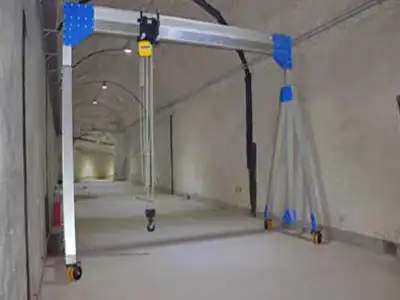
LT1: Aluminum Gantry Rolling Crane with Fixed Span and Height 5 Ton
Fixed span and height: Provides stable lifting support with consistent dimensions.
Constructed from lightweight aluminum: Offers durability and easy maneuverability.
Ideal for specific lifting needs: Suited for tasks requiring a fixed span and height.
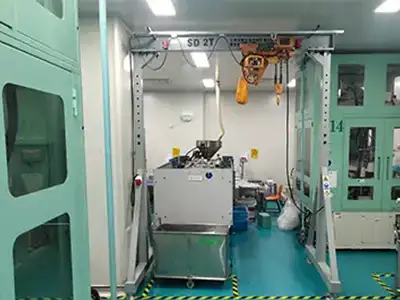
LT2: Height Adjustable Aluminum Gantry Rolling Cranes 5 Ton
Height adjustable design: Provides flexibility to adapt to varying lifting requirements.
Constructed from lightweight aluminum: Enables easy transportation and setup.
Versatile for different applications: Suitable for tasks where adjustable height is necessary.
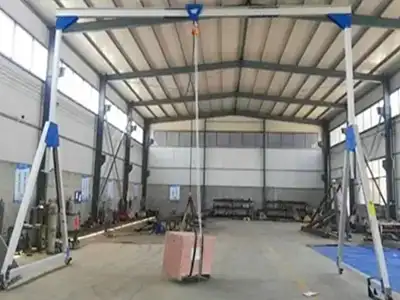
LT4: Simple Gantry Cranes with Adjustable Height & Span 2 Ton
Adjustable height and span: Provides versatility for different lifting needs.
Simple design for easy operation: Offers straightforward functionality.
Suitable for various industries: Ideal for tasks requiring adjustable height and span in a simple crane design.
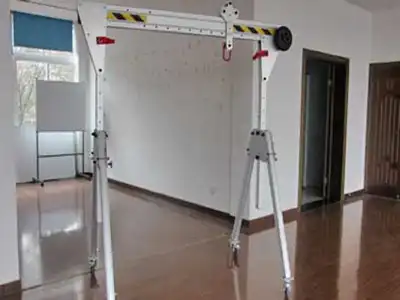
LT5: Foldable Aluminum Gantry Rolling Crane with Adjustable Span and Height 3 Ton
Foldable design for easy storage and transportation: Offers convenience in handling and setup.
Adjustable span and height: Provides flexibility for different lifting tasks.
Constructed from lightweight aluminum: Ensures portability without sacrificing strength.
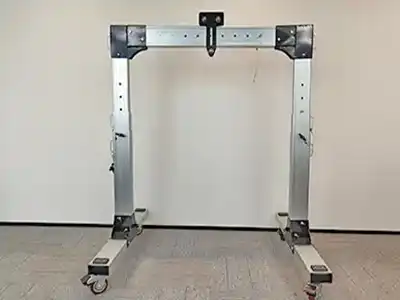
LT6: Adjustable Rolling Gantry Crane with Telescoping Height and Span T Frame Gantry Cranes 2 Ton
Telescoping height and span: Offers precise adjustment for specific lifting requirements.
T frame design for enhanced stability: Ensures reliable support during lifting operations.
Suitable for demanding applications: Ideal for tasks where precise adjustments are essential for safe and efficient lifting.
Applications of Aluminum Rolling Cranes
- Manufacturing: Aluminum rolling cranes are commonly used in manufacturing facilities for lifting and moving heavy materials, components, and products along assembly lines or between workstations.
- Construction: These cranes are valuable on construction sites for tasks such as hoisting building materials, equipment, and tools to elevated areas or across different areas of the site.
- Warehousing: In warehouses, aluminum rolling cranes facilitate efficient loading and unloading of goods from trucks, as well as moving pallets and containers within the facility.
- Maintenance and Repair: They are utilized in maintenance workshops for lifting machinery, engines, and other equipment for repair or servicing.
- Events and Entertainment: Aluminum rolling cranes are often used in event setups for lifting and positioning stage equipment, lighting rigs, and other production elements.
Advantages of Aluminum Rolling Cranes
- Portability: Being constructed from lightweight aluminum, these cranes are easily portable, allowing them to be moved to different locations within a facility or transported between sites.
- Versatility: Aluminum rolling cranes come in various configurations, including fixed height, adjustable height, and adjustable span, making them suitable for a wide range of lifting tasks and environments.
- Durability: Despite their lightweight construction, aluminum rolling cranes are durable and resistant to corrosion, ensuring long-term reliability even in demanding industrial environments.
- Easy Setup: They typically feature a simple assembly process, allowing them to be quickly set up and put into operation without the need for specialized tools or equipment.
- Efficient Operation: With smooth rolling mechanisms and precise controls, aluminum rolling cranes enable efficient and precise lifting operations, enhancing productivity and safety in the workplace.
Rolling Jib Cranes:
Rolling jib cranes or cantilever rolling cranes characterized by their jib or boom arm extending from a fixed vertical mast, offer a unique design for specific material handling needs. These cranes are distinguished by their rotational capability, allowing the jib to pivot or rotate, providing enhanced maneuverability in confined spaces.
The jib arm houses the hoisting mechanism, allowing vertical lifting and horizontal movement of loads. They are mounted on wheeled bases or tracks, enabling mobility across the workspace while offering a more localized and precise lifting approach compared to larger gantry cranes.
Types of Rolling Jib Cranes
Rolling jib cranes, also known as mobile jib cranes, offer versatile lifting solutions within different industrial and commercial settings. These cranes are characterized by their mobility and ability to cover a broader work area compared to stationary jib cranes. Here are some common types of rolling jib cranes:
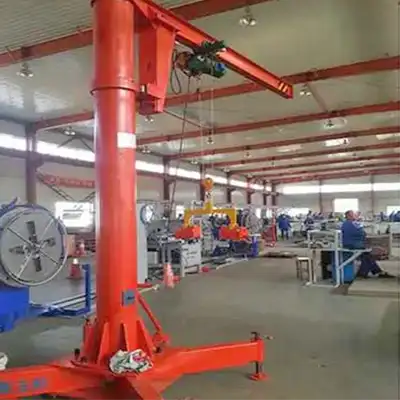
Manual Cantilever Rolling Cranes
Manually operated: Controlled by hand for precise handling.
Cantilever design: Extends horizontally for easy access to loads.
Versatile for various lifting tasks: Suitable for applications where manual operation is preferred.
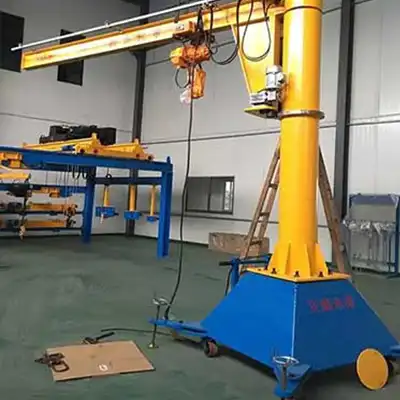
Electric Rotating Cantilever Rolling Cranes
Powered by electricity: Offers efficient and reliable lifting capabilities.
Cantilever design: Provides horizontal reach for accessing loads.
Ideal for medium to heavy lifting tasks: Suited for applications where powered operation is required.
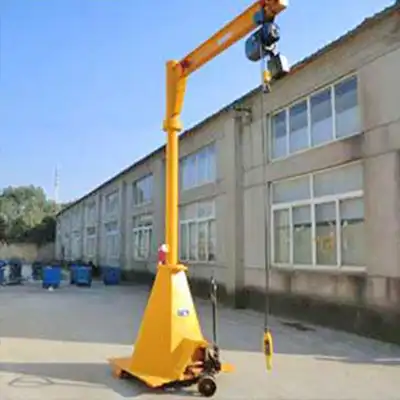
I-beam Cantilever Rolling Cranes
Utilizes I-beam construction: Offers strength and stability for lifting heavy loads.
Cantilever configuration: Extends horizontally for reaching loads.
Suitable for heavy-duty lifting tasks: Ideal for applications requiring robust crane support.
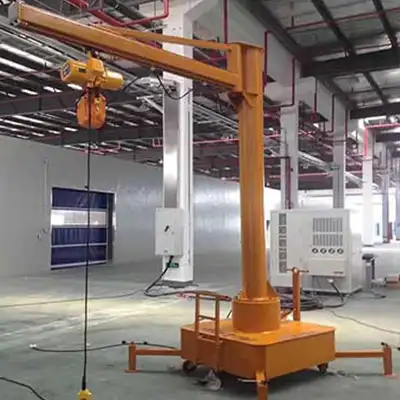
Tie Rod Cantilever Rolling Cranes
Incorporates tie rod construction: Provides structural support and stability.
Cantilever design: Extends horizontally for accessing loads.
Ideal for precise lifting tasks: Suited for applications where accurate positioning is necessary.
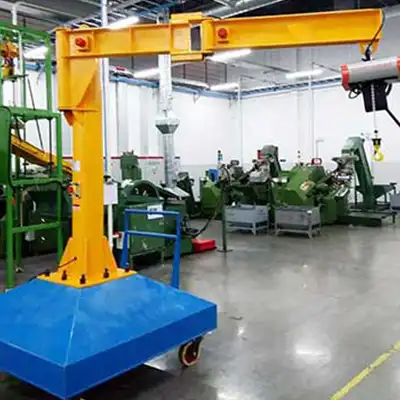
Articulating Cantilever Rolling Cranes
Articulating arm design: Offers flexibility in reaching and maneuvering around obstacles.
Cantilever structure: Provides horizontal reach for lifting operations.
Versatile for tight spaces: Ideal for applications where precise positioning is essential.
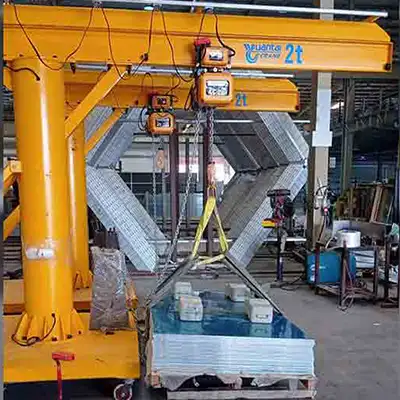
Custom Cantilever Rolling Cranes 2 Ton Project for Qatar
Articulating arm design: Offers flexibility and stability with 8 rollers .
Cantilever structure: Provides high vertical reach for lifting operations.
Versatile for construction site: Typically used on build top for construction material handling.
These various types of rolling jib cranes cater to different lifting requirements, offering flexibility, mobility, and adaptability across diverse industrial applications, enhancing efficiency in material handling and lifting operations.
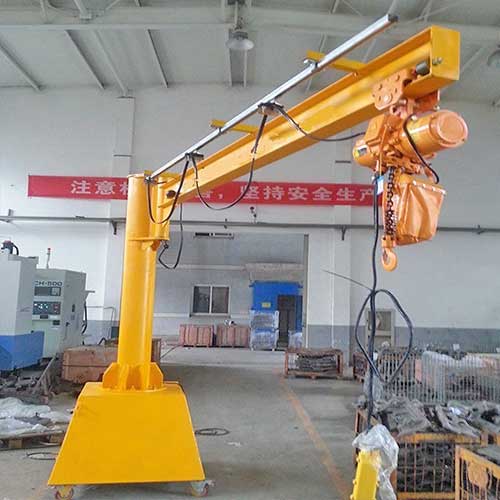
Benefits and Use in Industrial Environments
Rolling jib cranes offer several advantages in industrial settings:
Precise Load Positioning: Their ability to rotate or pivot provides accuracy in load placement, ideal for intricate handling tasks.
Localized Material Handling: Suited for specific workstations or areas where targeted lifting and movement are required.
Space Efficiency: Occupying less floor space compared to larger gantry cranes, they offer a space-saving solution.
Enhanced Versatility: Versatile design facilitates handling of loads with varying sizes and shapes.
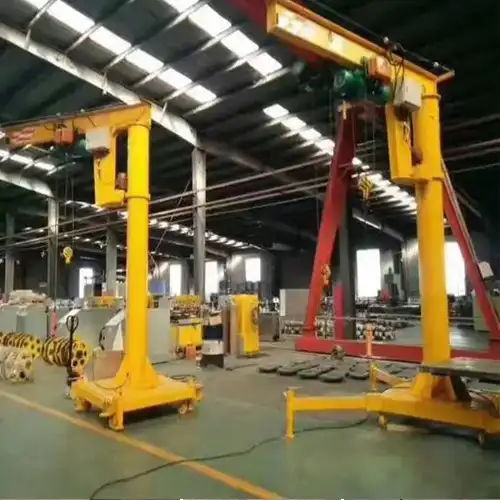
Versatility in Material Handling Tasks
Rolling jib cranes cater to various material handling tasks:
Assembly Lines: Used for handling components during assembly processes.
Workstations: Ideal for localized lifting and movement in specific work areas.
Tool Rooms or Maintenance Areas: Assists in lifting heavy tools and equipment.
Loading Docks: Aids in handling pallets and materials during loading/unloading processes.
Their versatility makes rolling jib cranes indispensable for targeted and precise material handling tasks, offering efficiency and flexibility in various industrial environments.
Overhead Rolling Cranes
Overhead rolling cranes, also known as overhead bridge cranes or movable overhead cranes, are a type of lifting equipment that operates on elevated runways or tracks. They consist of a bridge that traverses the length of the workspace along the elevated runways. The hoisting mechanism is attached to this bridge, enabling vertical lifting and horizontal movement of heavy loads.
The working mechanism involves the bridge moving along the runway supported by end trucks or wheels, with the hoist mechanism allowing controlled lifting, lowering, and precise positioning of loads. These cranes are designed to optimize vertical space utilization and provide efficient material handling solutions.
Types of Rolling Bridge Cranes
Rolling bridge cranes, also known as overhead cranes or bridge cranes, are versatile lifting systems commonly used in various industries for heavy material handling and load movement. These cranes run on elevated runways or tracks, providing a horizontal beam (bridge) along which the hoist and trolley can move. Here are some common types of rolling bridge cranes:
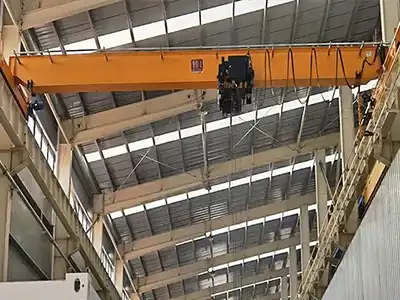
Single Girder Rolling Bridge Cranes 1 ton to 20 tons
Features Overview: Single girder cranes have one main horizontal beam (girder) supporting the hoist and trolley system.
Compact Design: They are typically lighter and more cost-effective, suitable for lower capacity lifting needs.
Typical Applications: Used in smaller manufacturing facilities, warehouses, or workshops for lighter to moderate load handling.
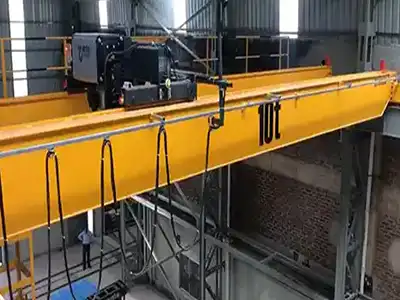
Double Girder Rolling Bridge Cranes 3 Ton to 80 Tons
Features Overview: These cranes have two horizontal beams (girders) supporting the hoist and trolley system.
Higher Capacity and Stability: Double girder cranes offer increased load capacity and stability compared to single girder cranes.
Typical Applications: Found in heavy industrial settings, steel mills, and facilities requiring lifting of heavier loads.
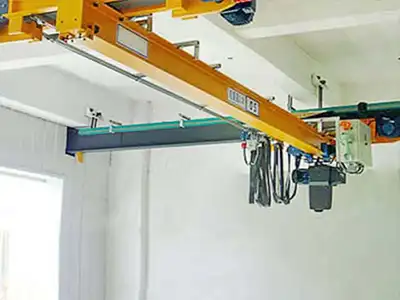
Under Running Rolling Bridge Cranes 0.5 Ton, 1 Ton, 2 Ton, 3 Ton, 5 Ton, 10 Tons
Features Overview: The crane wheels run on the lower flange of the runway beams, often installed on the bottom of the ceiling structure.
Space-Saving Design: These cranes do not require additional headroom, suitable for facilities with limited vertical space.
Typical Applications: Ideal for buildings with restrictive headroom or where overhead space is limited.
Key Features and Benefits
Overhead rolling cranes offer several key features and benefits:
Vertical Space Utilization: By operating overhead, they maximize floor space utilization in industrial settings.
High Load Capacities: Capable of handling heavy loads efficiently, contributing to enhanced productivity.
Precise Load Control: The hoist mechanism enables precise positioning of loads, increasing operational accuracy.
Safety Enhancements: Equipped with safety features like overload protection and emergency braking systems, ensuring a safe working environment.
Applications Across Various Industries
Overhead rolling cranes find diverse applications across industries:
Rolling shop cranes, also known as portable shop cranes or floor cranes, are compact and mobile lifting devices primarily used in workshops and maintenance facilities. These cranes typically have a sturdy steel construction and a hydraulic pump or winch mechanism for lifting.Their features often include adjustable booms, maneuverable wheels, and a swiveling hook, allowing flexibility in load handling. Rolling shop cranes find applications in:
Manufacturing: Used for assembly lines, transferring heavy materials, and facilitating production processes.
Warehousing: Efficiently manages material flow in warehouses, optimizing storage and retrieval operations.
Construction: Aids in lifting and positioning construction materials at building sites, improving efficiency.
Automotive and Aerospace: Critical for handling components during manufacturing processes.
Mining and Heavy Industries: Used in material handling operations involving substantial loads.
Maintenance Workshops: Lifting and handling heavy machinery or equipment.
Automotive Repair Shops: Assisting in engine or transmission removal/installation.
Assembly Lines: Aiding in component assembly processes.
Their adaptability and efficiency make overhead rolling cranes invaluable in various industries, contributing significantly to optimized material handling and operational efficiency.
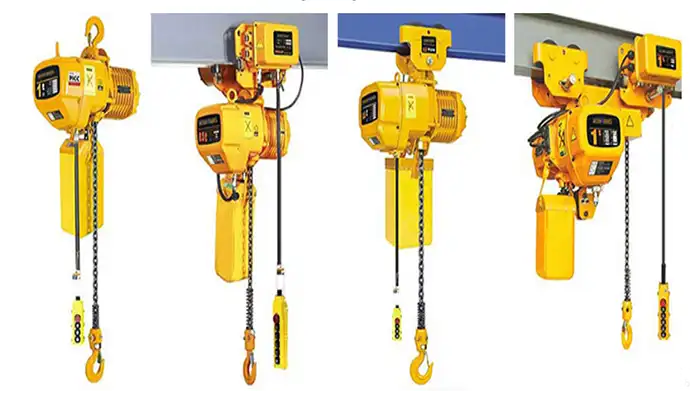
Rolling Crane Hoists: Versatile Lifting Solutions
Rolling crane hoists represent the lifting mechanisms integrated into rolling crane systems. These hoists come with various features and capabilities tailored for efficient material handling:
Variable Speed Controls: Allows precise control over lifting and lowering speeds, ensuring safe and accurate load positioning.
Durable Construction: Typically constructed with robust materials for handling heavy loads consistently.
Load Limiting Devices: Ensures safe operation by preventing hoisting loads beyond specified limits.
Different Mounting Options: Available in various mounting configurations to suit specific crane setups.
Compact Design: Often designed compactly to fit seamlessly within the rolling crane system.
Benefits in Material Handling and Assembly Processes
Rolling crane hoists offer several advantages in material handling and assembly processes:
Enhanced Efficiency: Facilitates quick and precise lifting, streamlining material handling tasks.
Improved Safety: Ensures safe and controlled lifting, reducing the risk of accidents or injuries.
Versatility: Adaptable to various load sizes and shapes, increasing operational flexibility.
Reduced Labor Intensity: Minimizes manual labor required for heavy lifting tasks, improving productivity.
Integration with Rolling Crane Systems
Rolling crane hoists are an integral part of rolling crane systems, providing the lifting power necessary for efficient material handling. They seamlessly integrate with the crane structure and controls, allowing coordinated movement and precise load handling.
The hoists are often designed to work in tandem with the mobility and functionality of rolling cranes, ensuring a comprehensive and efficient lifting solution within industrial settings.
Factors to Consider When Choosing a Rolling Crane
Load Capacity and Span Requirements
- Load Capacity: Assess the maximum weight the crane needs to lift regularly. Ensure the crane's capacity aligns with these requirements to prevent overloading.
- Span Length: Determine the crane's required span length to cover the entire area where lifting operations are necessary. It ensures optimal coverage within the workspace.
Mobility and Adaptability in Different Work Environments
- Maneuverability: Evaluate the crane's mobility across various terrains or floors within the workspace. Consider wheel designs or track systems for seamless movement.
- Adaptability: Ensure the crane's adaptability to different work environments, such as factories, warehouses, or construction sites, without compromising functionality.
Safety Features and Compliance Standards
- Safety Mechanisms: Prioritize cranes equipped with safety features like overload protection, emergency braking systems, and limit switches to ensure safe operations.
- Compliance Standards: Ensure the crane complies with industry safety standards and regulations, prioritizing workplace safety and legal requirements.
Customization Options and Add-Ons for Enhanced Functionality
- Tailored Solutions: Assess the availability of customization options to tailor the crane's specifications to specific operational needs.
- Additional Features: Consider add-ons such as remote control systems, load monitoring devices, or environmental protection features for increased efficiency and safety.
Benefits and Cost Efficiency of Rolling Cranes
Increased Efficiency in Material Handling Processes
Rolling cranes significantly enhance material handling efficiency through various means:
Streamlined Operations:
Swift and Precise Load Handling: Rolling cranes facilitate quick and accurate movement of loads along designated paths, minimizing downtime and optimizing workflow within industrial settings.
Enhanced Control and Maneuverability: The ability to maneuver and position loads precisely streamlines operations, ensuring swift and efficient material transport.
Reduced Manual Labor:
Minimized Physical Strain: Rolling cranes decrease reliance on manual lifting, reducing physical strain on workers and minimizing the risk of workplace injuries associated with heavy lifting tasks.
Increased Safety: Automation in material handling minimizes human intervention, contributing to a safer work environment by reducing potential accidents caused by manual handling errors.
Improved Time Management:
Accelerated Processes: Swift load movement and positioning enable faster completion of tasks, leading to improved time management within operational workflows.
Optimized Productivity: Efficient material handling processes help in meeting production deadlines, enhancing overall operational efficiency and productivity.
Enhanced Flexibility and Adaptability:
Versatile Load Handling: Rolling cranes offer adaptability in handling various load types, sizes, and shapes, accommodating diverse industrial requirements without compromising efficiency.
Multi-Point Access: Ability to cover a broader work area or multiple workstations allows for increased flexibility in material handling operations.
Cost Savings and Resource Optimization:
Reduced Operational Costs: By streamlining operations, minimizing downtime, and optimizing workflow, rolling cranes contribute to cost savings by enhancing operational efficiency.
Reduced Maintenance Costs: Well-maintained rolling cranes experience fewer breakdowns, resulting in lower maintenance costs and increased equipment longevity.
Rolling cranes, through their efficiency, precision, and minimized manual labor requirements, contribute significantly to improved productivity, safety, and cost-effectiveness in material handling processes across various industrial sectors.
Impact on Productivity and Operations
Rolling cranes positively impact productivity and operational efficiency in several ways:
Enhanced Workflow:
Efficient Material Handling: Rolling cranes streamline material handling processes, facilitating smoother operations by swiftly moving loads within the workspace.
Reduced Congestion: Efficient load movement minimizes congestion in work areas, allowing for smoother workflow and reducing bottlenecks in operations.
Optimized Resource Utilization:
Maximized Workspace Potential: Rolling cranes utilize vertical and horizontal space efficiently, optimizing the workspace layout and reducing the need for additional floor space.
Space-Saving Design: Overhead or gantry cranes' elevated positioning frees up floor space for other operations or equipment, maximizing resource utilization.
Faster Turnaround Times:
Swift Load Handling: The ability of rolling cranes to swiftly handle loads accelerates project completion or manufacturing cycles.
Improved Lead Times: Quicker material handling processes contribute to shorter lead times, meeting deadlines more effectively.
Increased Throughput and Output:
Continuous Operation: Efficient material movement facilitates a continuous workflow, increasing throughput by minimizing idle time.
Higher Output Rates: Swift and precise load handling results in higher output rates and increased production capacities.
Operational Flexibility:
Adaptability to Changing Needs: Rolling cranes offer flexibility in handling various loads and adapting to changing operational requirements, ensuring seamless operations even in dynamic environments.
Multi-Functional Usage: The ability to cover multiple workstations or areas increases operational versatility and productivity.
Rolling cranes play a pivotal role in boosting productivity by ensuring efficient workflow, optimizing resource utilization, and expediting turnaround times in industrial operations. Their contribution to streamlined operations and increased throughput results in more efficient and productive work environments.
Cost Analysis and Return on Investment (ROI) for Rolling Crane Buyers
For potential buyers of rolling cranes, conducting a comprehensive cost analysis and assessing the Return on Investment (ROI) is crucial for informed decision-making:
Initial Investment vs. Long-Term Benefits:
Upfront Costs vs. Long-Term Gains: Evaluate the initial investment required for acquiring rolling cranes against the anticipated long-term benefits.
Factors to Consider: Include increased productivity, reduced labor costs, and operational efficiencies derived from using rolling cranes in the cost analysis.
ROI Calculation:
Comparing Investment and Returns: Calculate the Return on Investment (ROI) by assessing the total investment in acquiring the rolling crane against the expected returns over the crane's operational lifespan.
Consideration of Productivity Gains: Factor in the anticipated productivity improvements and cost savings achieved through efficient material handling when calculating ROI.
Maintenance Costs and Lifespan:
Assessing Ongoing Maintenance Expenses: Evaluate the ongoing maintenance costs required to upkeep the rolling crane throughout its operational life.
Lifespan Consideration: Consider the expected lifespan of the rolling crane concerning maintenance costs to determine the net ROI over the crane's service life.
Operational Efficiency and Cost Savings:
Quantify Efficiency Gains: Factor in the efficiency gains achieved by implementing rolling cranes, including minimized downtime, reduced labor-intensive tasks, and optimized workflow.
Labor Cost Reduction: Account for the potential reduction in labor costs resulting from decreased reliance on manual lifting tasks.
Total Cost of Ownership (TCO):
Comprehensive Cost Evaluation: Consider the Total Cost of Ownership (TCO) by assessing the sum of initial investment, operating costs, maintenance expenses, and anticipated benefits over the crane's lifecycle.
By conducting a thorough cost analysis and ROI assessment, potential buyers of rolling cranes can make informed decisions by weighing the initial investment against the long-term benefits and evaluating the overall cost-effectiveness and returns derived from implementing rolling crane solutions.
Conclusion: Get Your Custom Rolling Cranes and Hoists for Your Needs
Evolution of Rolling Cranes in Industrial Operations
The evolution of rolling cranes continues to reshape industrial operations:
Technological Advancements: Integration of smart controls, automation, and sensor technology enhancing crane functionalities.
Adaptability: Cranes designed for versatile applications across evolving industrial landscapes.
Efficiency and Safety: Continued improvements ensuring enhanced efficiency and adherence to stringent safety standards.
The Continued Importance and Advancements in Rolling Crane Technology
The future of rolling cranes is promising:
Innovation Drive: Further advancements to meet specific industry demands for efficiency and flexibility.
Sustainability Focus: Integration of eco-friendly features to align with sustainability goals.
Digital Integration: Incorporation of data analytics and connectivity for smarter, data-driven operations.
Rolling cranes remain pivotal in material handling operations, and their continued advancements promise to revolutionize industrial processes, ensuring enhanced efficiency, productivity, and safety for years to come. If you have any need of rolling hoists and rolling cranes, please feel free to contact us to check what we can do to save your cost.
Related Products

Latest project
150 Ton Overhead Crane Installation Feedback – Paraguay Case
QDX 150 ton overhead crane in action in Paraguay. Installation photos, video, and client feedback show performance, safety, and heavy-lifting efficiency.
Free consultation to Confirm Parameters & Specifications and Get
Latest Crane Price & Crane Rate.
- Types of overhead cranes : _______?
- Optional: Overhead travelling crane, goliath gantry crane,Slewing jib crane, Single girder or double girder crane,small portable crane or kbk crane, etc.
- Capacity of overhead crane: _______?
- Optional: 0.25ton, 0.5 ton, 1 ton, 2 ton, 3ton, 5 ton, 10 ton,15ton, 20ton, 25 ton, 30ton,35ton, up to 550ton, etc.
- Crane span & lifting height : _______?
- Crane travelling length : _____?
- Control of overhead crane:_______?
- Optional: pendant/ remote/cabin control
- Voltage supply of overhead crane:_____?
- Eg,: 380V50/60HZ,3Phase or others,etc.
- Application/usage of crane:_______?
- Eg,: Steel mill, ,injection mold, cement,stone, concrete,granite, general manufacturing, etc.
Just leave a message via the contact form and our hoist and crane engineer will contact you with in 24working hours.
Get In Touch
